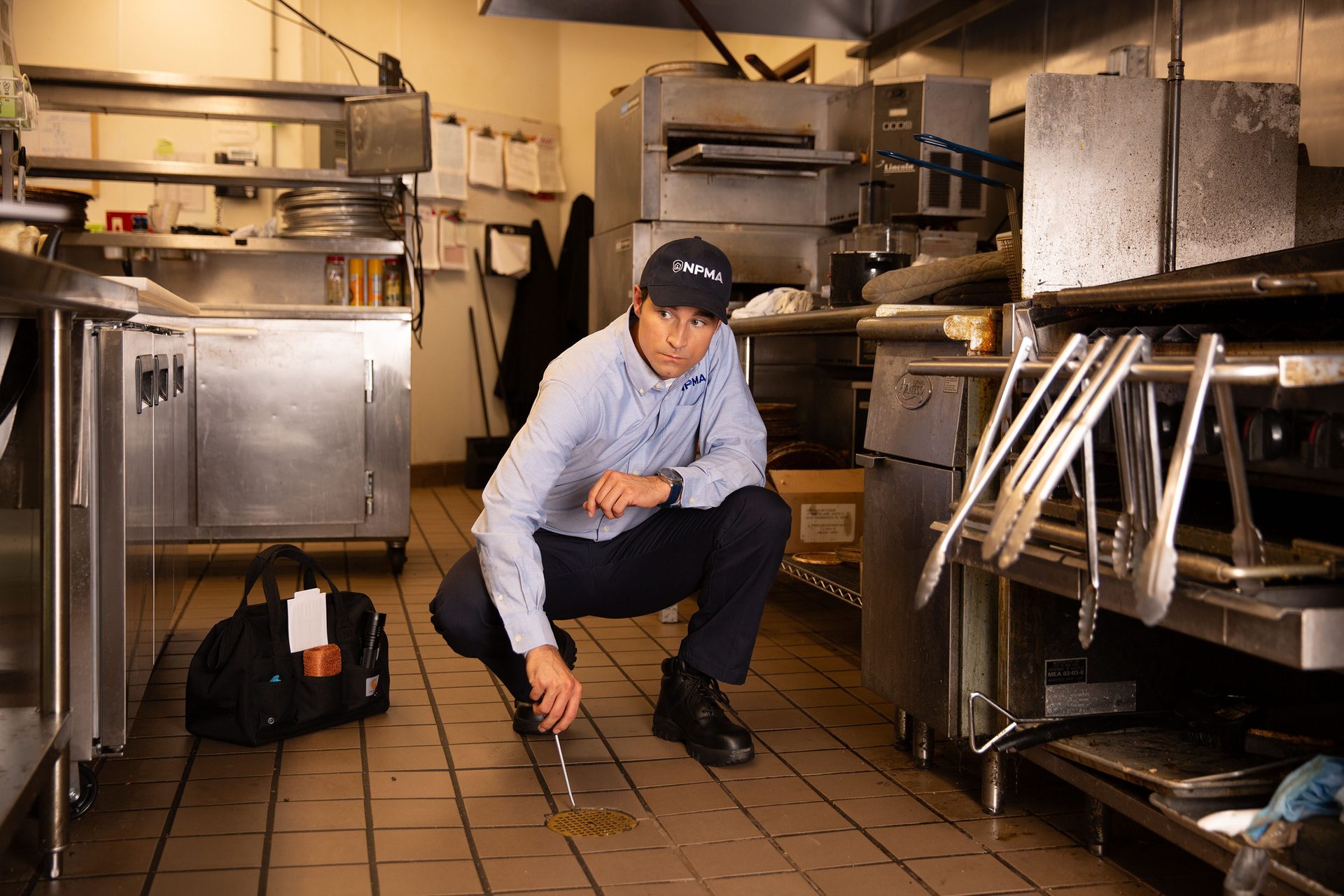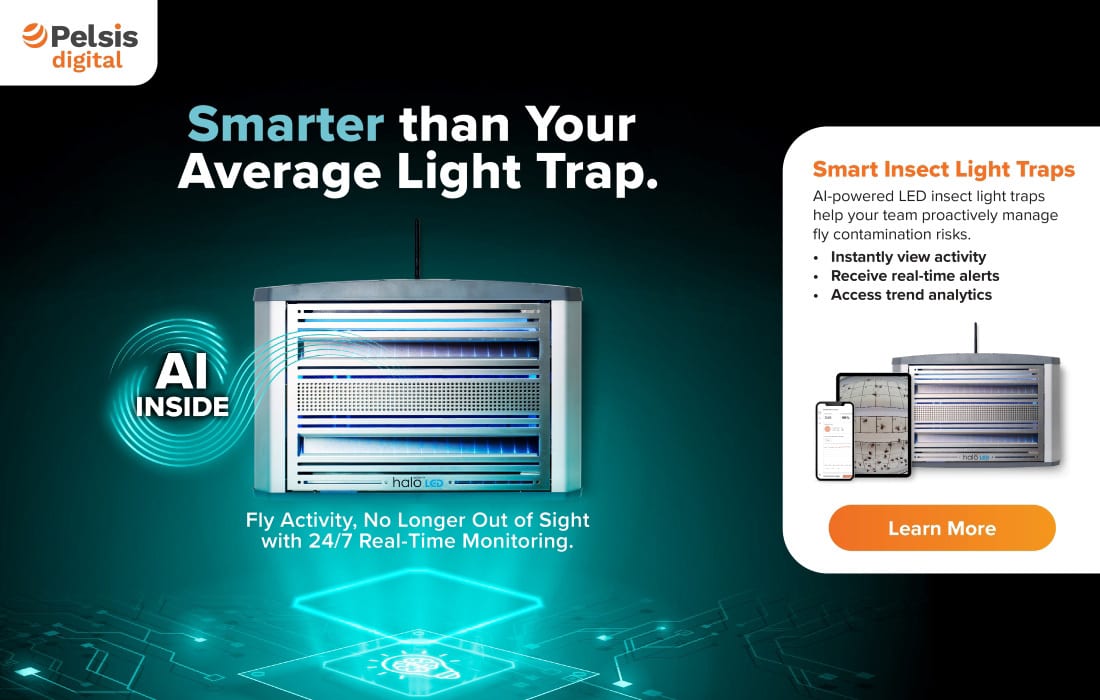SANITATION
By Jim Fredericks, Senior Vice President of Public Affairs, National Pest Management Association
Summer Pest Pressures: How Businesses Can Prepare
Food facility managers must understand the complexities of pest control and how to mitigate risks with proper planning

Image credit: National Pest Management Association (NPMA)
SCROLL DOWN
As the summer months approach, many businesses in the food industry face a persistent challenge: an uptick in pest pressure. For facility managers in food processing, foodservice, and related sectors, this time of year presents threats that can not only damage their business' reputation, but also pose a significant risk to food safety. It is crucial for facility managers to understand the complexities of pest control in food facilities and how to mitigate risks with proper planning.
The key to achieving long-term pest management success is fostering a year-round, collaborative relationship between facility managers and a professional pest control partner to implement an integrated pest management (IPM) plan.
Seasonal Pest Threats
As temperatures rise, pest activity typically increases. Many common pests—including rodents, flies, cockroaches, and stored product pests—thrive in warm conditions, and the resources in food facilities make them a prime target for infestations. Once an infestation occurs, these pests can compromise the integrity of products, packaging, and structures. Most importantly, they pose serious risks to food safety.
Summer months bring unique challenges for pest management. Understanding the specific pest risks during this time can help businesses better prepare and implement focused and effective strategies. Pests that facility managers should be particularly mindful of during summer include:
- Rodents, such as mice and rats, are active year-round, but the summer heat can push them to seek shelter in cooler, food-rich environments. Their activity may also increase as they search for food and water sources, making food processing or preparation areas most vulnerable. These pests are carriers of diseases like Salmonella, Escherichia coli, and hantavirus. They spread these pathogens through their urine, droppings, and saliva, contaminating food and equipment. Their gnawing can also damage packaging and facility structures.
- Cockroaches have been reported to spread at least 33 kinds of bacteria, including Salmonella and E. coli. They carry the bacteria on their bodies and feces, contaminating food and surfaces as they move throughout the facility. Cockroaches can also trigger asthma and allergy symptoms in workers.
- Flies, including house flies, fruit flies, and drain flies, are common during the summer months, posing a significant threat to food facilities because of their ability to carry bacteria and disease-causing pathogens. House flies, in particular, are capable of transferring more than 100 pathogens including Campylobacter, Salmonella, and E. coli. They breed in decaying organic matter and transfer pathogens to food surfaces, creating a major risk of cross-contamination.
- Stored product pests, such as merchant grain beetles and Indian meal moths, target dry food goods and can contaminate products with their waste and eggs. Although they do not spread diseases directly, they cause significant damage to inventory, risking food safety. These pests are particularly active in warmer months, so it is essential to inspect food storage areas regularly and rotate stock to ensure that older products are used first, reducing the risk of an infestation.
"Facility managers in the food industry should never rely solely on reactive measures to deal with pest problems."

While summer may mark the height of pest activity, it is important to understand that pests do not disappear once the cooler months return. The best approach to pest management is a proactive one that spans the entire year, with extra attention during the summer months when pest activity is most prevalent.
A Year-Round Approach to Pest Management
Facility managers in the food industry should never rely solely on reactive measures to deal with pest problems. The key to preventing infestations and mitigating the risks posed by pests is an integrated pest management (IPM) plan that addresses pest issues holistically, before they can escalate. IPM is a common-sense way for a business to address its pest problems. This method of pest control takes a comprehensive approach through basic techniques: preventing pests, monitoring for pests, and implementing control methods when needed. By working closely with pest control professionals, businesses can implement strategies that prevent infestations, maintain pest-free environments, and ensure compliance with food safety regulations.
An effective IPM program involves several essential components:
- Inspection and monitoring: A critical first step in managing pests is thoroughly inspecting the facility to identify signs of pest activity and potential vulnerabilities. Routine inspections are essential for pinpointing areas where pests may enter, breed, or feed, such as cracks in walls, gaps in doors or windows, or food storage areas. Facility managers should regularly engage their pest control partner to conduct comprehensive pest audits, helping to identify issues that may not be immediately visible.
- Exclusion and sanitation: Preventing pest infestations is the ultimate goal of any IPM program. Once areas of vulnerability are identified, immediate steps should be taken to seal off entry points and minimize food sources that could attract pests. This might involve repairing cracks, replacing weather stripping around doors, and installing or improving screens on vents. Additionally, maintaining proper sanitation protocols is critical to reducing food and water sources for pests. Regular cleaning of surfaces, drains, and storage areas, along with proper waste management, can dramatically reduce the chances of an infestation.
- Control methods: Non-chemical methods of pest control, such as traps, can be used to capture and monitor pests without the use of traditional pest control products. While treatment alone should never be the sole component of an IPM plan, it can be an important tool when used as part of a broader strategy. Facility managers should work with their professional pest control partner to choose the most effective, targeted products; ensure they are registered for use at their location; and verify proper application.
- Ongoing evaluation and communication: Pest control is not a one-time solution. Pest pressures vary based on seasonality, changes in the environment, and other factors, so it is essential to continuously evaluate and adapt pest management strategies. A good IPM program involves regular follow-up inspections, monitoring, and real-time adjustments. Clear communication between facility managers and pest control professionals is key to keeping the facility pest-free. Establishing ongoing training and open lines of communication ensures that the entire staff is aligned and able to act swiftly if a pest issue arises.
Building a Strong Partnership and Continuing Education
A successful IPM program requires a strong partnership among facility managers, employees, and their pest control partner. While facility teams play a key role in prevention, pest control professionals bring essential knowledge to develop and implement strategies tailored to the facility's needs. Clear communication and regular updates ensure that pest issues are addressed quickly and control strategies are adjusted as needed.
"Staff training should cover best practices for building maintenance and sanitation, as well as how to report pest sightings promptly, ensuring that potential issues are addressed before they escalate into larger problems."

Equally important is the role of food facility employees. Staff members are the first line of defense in maintaining cleanliness, identifying early signs of infestations, and ensuring that sanitation practices are consistently followed. Ongoing training programs and standard operating procedures (SOPs) equip employees with the knowledge and skills necessary to prevent, recognize, and respond appropriately to pest issues. This training should cover best practices for building maintenance and sanitation, as well as how to report pest sightings promptly, ensuring that potential issues are addressed before they escalate into larger problems. Together, these efforts create a robust, continuous plan that keeps food facilities safe and compliant with food safety regulations.
“Each step in the 'rings of defense' must be used consciously and with proper consideration, as it may be obvious what caused the noncompliance, and its resolution may be straightforward, simple, and not costly.”


Pest Prevention
While a trained pest control partner can provide tips tailored to a facility's unique needs and vulnerabilities, the following tips will help prevent pest issues and ensure a safer, cleaner, and more efficient environment:
- Ensure that kitchens and break rooms are clean by wiping down counter tops and sweeping floors to remove crumbs and residue from spills.
- Develop a schedule for deep cleaning (including moving and disassembly of equipment) to ensure that hard-to-reach areas are not neglected.
- Routinely check under sinks and machinery for areas of moisture and repair any leaky pipes or dirty/clogged drains.
- Store all food products in sealed containers and organize storage facilities to prevent harborage areas.
- Keep trash in sealed containers inside the building and remove from the facility regularly. Ensure that dumpsters are located far away from building entry points.
- Inspect the exterior of the building to ensure there are no entry points for pests, paying close attention to areas where pipes and utilities enter the building, and seal any gaps or cracks in the foundation.
- Install door sweeps on the exterior doors to seal the gap between the floor and the door where pests can enter.
- Keep exterior doors closed; do not allow doors to be propped open.
- Remove debris from gutters and direct water away from the building through properly functioning downspouts and gutters.
- Install a gravel perimeter around the building to help discourage vegetation growth that could harbor pests.
- Ensure that the grounds surrounding the facility are properly maintained, as overgrown vegetation can attract pests.
At the core of effective pest control is IPM—a comprehensive strategy that combines inspections, sanitation, exclusion, and the use of both mechanical and chemical controls. However, a successful IPM program requires more than the expertise of pest control professionals. It is truly a collaborative effort, with facility managers, employees, and pest control teams working together to monitor pest activity, address potential vulnerabilities, and continuously improve pest control efforts.
As we move into the warmer months, the challenges posed by pests in food facilities become even more pronounced. The risks they introduce to food safety and facility integrity can be serious, but by taking a proactive, year-round approach to pest management, facility managers can reduce these threats and ensure a safer, pest-free environment.
With a shared commitment to food safety and pest management, companies can protect their brand, their products, and most importantly, their customers from the risks associated with pest infestations.
References
- Thomson, A. and M. Wilson, "Building a Skilled and Capable Workforce for the Food Industry: Simplifying Food Safety Language." Food Safety Magazine. December 31, 2023. https://www.food-safety.com/articles/10001-building-a-skilled-and-capable-workforce-for-the-food-industry-simplifying-food-safety-language.
- New South Wales Food Authority. "Biosecurity and Food Safety: Listeria Outbreak Investigation Summary Report for the Melon Industry." October 2018. https://www.foodauthority.nsw.gov.au/sites/default/files/_Documents/foodsafetyandyou/listeria_outbreak_investigation.pdf.
Jim Fredericks is the Senior Vice President of Public Affairs for the National Pest Management Association (NPMA).


